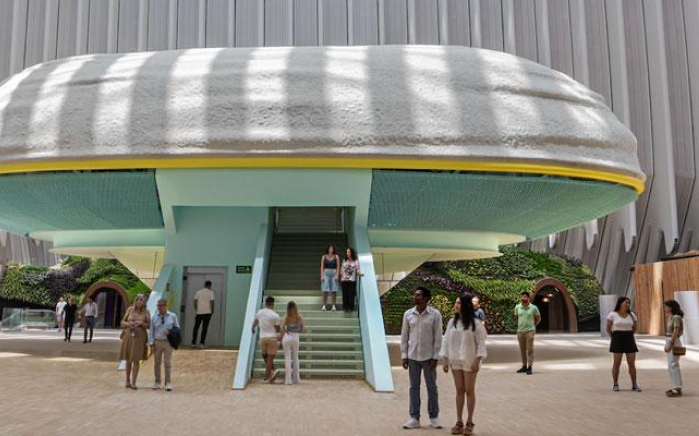- Inicio
- ->
- Architecture
Architecture
SCIENCE, NATURE AND ART IN A COMPLEX DEVOTED TO SCIENTIFIC AND CULTURAL DISSEMINATION IN EUROPE, PLACED IN VALENCIA.

Discover
The City of Arts and Sciences in Valencia is a unique complex devoted to scientific and cultural dissemination which is made up of five main elements: the Hemisfèric, IMAX cinema and digital projections; the Umbracle, a landscaped vantage point and car park; the Science Museum, an innovative centre of interactive science: the Oceanogràfic, the largest aquarium in Europe; the Palau de les Arts, which takes care of the operatic programme, and the Ágora, which hosts the CaixaForum.
Along an axis of just under two kilometres that was formerly the bed of the River Turia, this complex promoted by the Generalitat Valenciana has striking architecture – designed by Santiago Calatrava and Félix Candela – and an endless capacity for entertaining and stimulating the minds of its visitors. In its various buildings they can get to know different aspects of science, technology, nature, and art.
The significant part placed by architecture has been possible thanks to the outstanding work of two Spanish architects of international prestige: Santiago Calatrava with the Palau de les Arts (Opera House), Hemisfèric (Imax and Full Dome), Science Museum, Umbracle, (Promenade and Car Park), and the Agora, and Félix Candela with the striking roofs of the main buildings of the Oceanogràfic (Aquarium). An architectural complex of exceptional beauty has thus been formed to harmonise the continent with the content. It is a city in which the light and sea of the Mediterranean coexist in a striking manner.
History

CIUDAD DE LAS ARTES Y DE LAS CIENCIAS, S. A.
In July 1996, Ciudad de las Artes y las Ciencias, S.A. was founded, following a change in company name from Vacico (Valencia, Ciencia y Comunicaciones), a trading company run by the Government of Valencia. The name change also coincided with a change in corporate purpose, to adapt it to the new projects planned by the Valencian Government.
The project, designed by the Valencian architect Santiago Calatrava was constructed on the former bed of the River Turia.
Following catastrophic flooding in 1957, the river was diverted in the southern section of the city and the old riverbed, now dry was used to create a ten kilometre long park crossing the city centre. It was here that it was decided to locate the new complex, on flat land on the right bank of the final stretch of what was once the River Turia.

Hemisfèric
Architect: Santiago Calatrava
Opening year: 1998
Hemisfèric is a remarkable and spectacular building designed by Santiago Calatrava that represents a huge human eye, the eye of wisdom.
This symbolises the observation of the world that visitors discover by means of surprising audiovisual projections.

Museu de les Ciències
Architect: Santiago Calatrava
Opening year: 2000
he exterior of this museum captivates the visitor in its own right. The building is magnificent in its proportions and organic shapes and houses a multitude of activities and initiatives related to the evolution of life and scientific and technological dissemination.
The Museum has a personality of its own, in the modern architectural style that turns the containers of museums into parts of the collection or contents of the same. The huge size of the museum allows it to house various types of activities at the same time, as opposed to smaller museums that have a function limited to a particular field of science or nature.
The huge size of the museum allows it to house various types of activities at the same time, as opposed to smaller museums that have a function limited to a particular field of science or nature.

Oceanogràfic
Architect: Félix Candela
Opening year: 2002
The Oceanogràfic of the City of Arts and Sciences is the largest aquarium in Europe and contains representatives of the world’s main marine ecosystems. Each building is identified with the following aquatic environments: the Mediterranean, Wetlands, Temperate and Tropical Seas, Oceans, the Antarctic, the Arctic, Islands, and the Red Sea, as well as the Dolphinarium.
Palau de les Arts
Architect: Santiago Calatrava
Opening year: 2005
This majestic building, designed by the Valencia architect and engineer Santiago Calatrava, means that both the city and the Region of Valencia have the best infrastructure available in order to participate on international circuits, especially those of opera and major musical shows.


Umbracle
Architect: Santiago Calatrava
Opening year: 2000
Spectacular gardened esplanade and exhibition zone with incredible views to the whole complex, which houses a large car park.
The Umbracle is a vantage point of over 14,000 square metres with an exhibition zone from which all the buildings, lakes, walkways, and landscaped areas of the City of Arts and Sciences can be contemplated.
Its vegetation is characteristic of the Mediterranean, of the Region of Valencia, and of tropical countries, and changes according to the season of the year; it also contains an interesting exhibition of contemporary sculptures by internationally acknowledged artists.

Àgora
Architect: Félix Candela
Opening year: 2009
CaixaForum Valencia is located in the heart of the Àgora structure in the Ciutat de les Arts i les Ciències, between the Assut de l’Or bridge and the Oceanogràfic, to be precise.
It is an multi-purpose space for promoting knowledge, science and culture as agents of social improvement.
CaixaForum provides an array of very diverse and versatile cultural offerings. From art expositions, lecture series, concerts and shows, social seminars, even family and education workshops designed for all ages.


